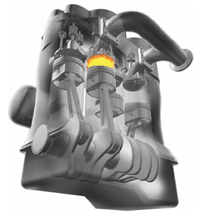Up to 36% less fuel with split-cycle engine
- Details
- Hits: 8002
 The latest computer simulations confirm the enormous consumption advantages of the Scuderi split-cycle engine: As a naturally aspirated gasoline engine in a mid-range car (Chevrolet Cavalier), it consumes 25% less fuel, and an air hybrid engine even 30 to 36% less than conventional gasoline engines. The simulation data and computer models are based on the results of the extensive test program that the prototype of the Scuderi engine is currently undergoing at the independent Southwest Research Institute in San Antonio, Texas.
The latest computer simulations confirm the enormous consumption advantages of the Scuderi split-cycle engine: As a naturally aspirated gasoline engine in a mid-range car (Chevrolet Cavalier), it consumes 25% less fuel, and an air hybrid engine even 30 to 36% less than conventional gasoline engines. The simulation data and computer models are based on the results of the extensive test program that the prototype of the Scuderi engine is currently undergoing at the independent Southwest Research Institute in San Antonio, Texas.
The Scuderi split-cycle engine is the first engine in 130 years to use a new thermodynamic combustion principle. Unlike the conventional gasoline engine split-cycle engine, the four power strokes are divided into two cylinders and the fuel-air mixture ignites in the combustion cylinder until after top dead center. As a result, the mixture burns more efficiently, which increases performance and lowers consumption and emissions.
 Kettcar for adults creates a range of up to 200 km
Kettcar for adults creates a range of up to 200 km
"We will even improve on these initial results," said Sal Scuderi, president of the Scuderi Group. "Our basic engine, the split-cycle engine as a naturally aspirated gasoline engine, undergoes a permanent optimization process and the performance of the air hybrid engine will continue to improve just by increasing the pressure in the air tank. With a modified engine we will further increase the efficiency values. To illustrate this, we're simulating a Nissan Sentra of the 2011 model year with a Scuderi engine on the computer. "Preliminary data from the simulation with a Chevrolet Cavalier from the 2004 model year show that the Scuderi split-cycle engine offers a good opportunity for automakers to meet increasingly stringent emissions standards.
The Scuderi engine is considered to be the most important innovation in the internal combustion engine since the invention of the Otto engine more than 130 years ago. It works with a new thermodynamic combustion process, the so-called split-cycle principle. The four strokes of a conventional internal combustion engine are divided into two paired cylinders: The first part of the cylinder pair is responsible for intake and compression and, after its work cycle, sends highly compressed air to its counterpart, where after the fuel is injected and ignition is followed by the upper part Dead center a particularly efficient and clean combustion takes place. Since the cylinder pair work simultaneously, the Scuderi engine completes a complete work cycle in just one revolution of the crankshaft. Conventional engines need two revolutions to complete one work cycle. The first tests have shown that the Scuderi engine, in addition to its high efficiency and significant reduction in emissions, also achieves more power and higher torque than conventional gasoline or diesel engines.
